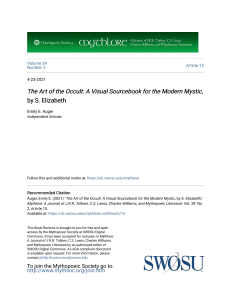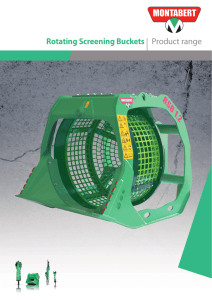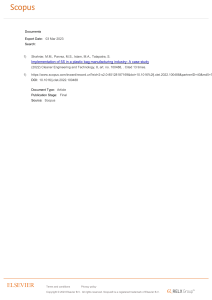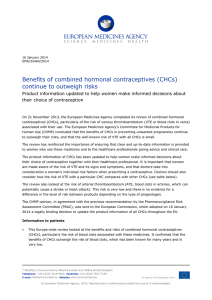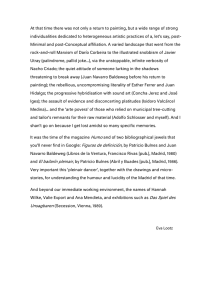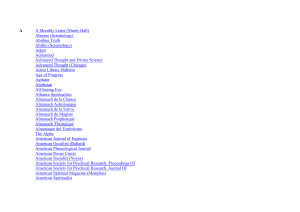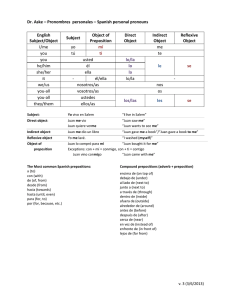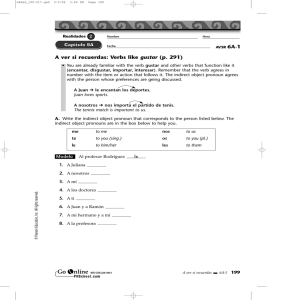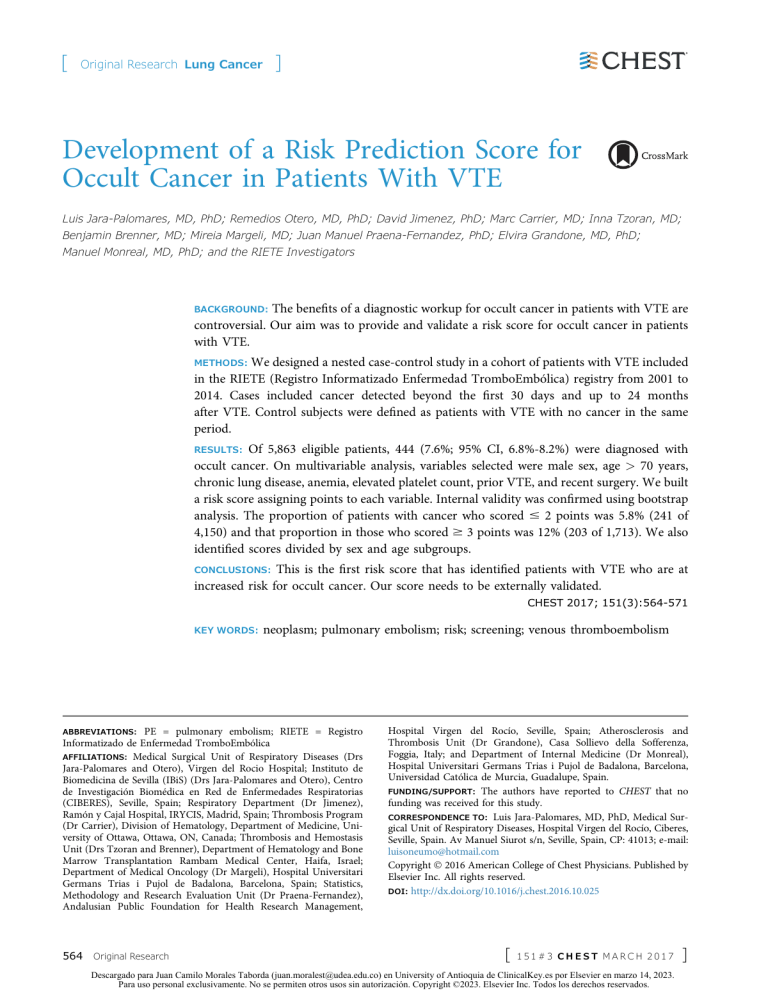
[ ] Original Research Lung Cancer Development of a Risk Prediction Score for Occult Cancer in Patients With VTE Luis Jara-Palomares, MD, PhD; Remedios Otero, MD, PhD; David Jimenez, PhD; Marc Carrier, MD; Inna Tzoran, MD; Benjamin Brenner, MD; Mireia Margeli, MD; Juan Manuel Praena-Fernandez, PhD; Elvira Grandone, MD, PhD; Manuel Monreal, MD, PhD; and the RIETE Investigators The benefits of a diagnostic workup for occult cancer in patients with VTE are controversial. Our aim was to provide and validate a risk score for occult cancer in patients with VTE. BACKGROUND: METHODS: We designed a nested case-control study in a cohort of patients with VTE included in the RIETE (Registro Informatizado Enfermedad TromboEmbólica) registry from 2001 to 2014. Cases included cancer detected beyond the first 30 days and up to 24 months after VTE. Control subjects were defined as patients with VTE with no cancer in the same period. Of 5,863 eligible patients, 444 (7.6%; 95% CI, 6.8%-8.2%) were diagnosed with occult cancer. On multivariable analysis, variables selected were male sex, age > 70 years, chronic lung disease, anemia, elevated platelet count, prior VTE, and recent surgery. We built a risk score assigning points to each variable. Internal validity was confirmed using bootstrap analysis. The proportion of patients with cancer who scored # 2 points was 5.8% (241 of 4,150) and that proportion in those who scored $ 3 points was 12% (203 of 1,713). We also identified scores divided by sex and age subgroups. RESULTS: CONCLUSIONS: This is the first risk score that has identified patients with VTE who are at increased risk for occult cancer. Our score needs to be externally validated. CHEST 2017; 151(3):564-571 KEY WORDS: neoplasm; pulmonary embolism; risk; screening; venous thromboembolism ABBREVIATIONS: PE = pulmonary embolism; RIETE = Registro Informatizado de Enfermedad TromboEmbólica AFFILIATIONS: Medical Surgical Unit of Respiratory Diseases (Drs Jara-Palomares and Otero), Virgen del Rocio Hospital; Instituto de Biomedicina de Sevilla (IBiS) (Drs Jara-Palomares and Otero), Centro de Investigación Biomédica en Red de Enfermedades Respiratorias (CIBERES), Seville, Spain; Respiratory Department (Dr Jimenez), Ramón y Cajal Hospital, IRYCIS, Madrid, Spain; Thrombosis Program (Dr Carrier), Division of Hematology, Department of Medicine, University of Ottawa, Ottawa, ON, Canada; Thrombosis and Hemostasis Unit (Drs Tzoran and Brenner), Department of Hematology and Bone Marrow Transplantation Rambam Medical Center, Haifa, Israel; Department of Medical Oncology (Dr Margeli), Hospital Universitari Germans Trias i Pujol de Badalona, Barcelona, Spain; Statistics, Methodology and Research Evaluation Unit (Dr Praena-Fernandez), Andalusian Public Foundation for Health Research Management, 564 Original Research Hospital Virgen del Rocío, Seville, Spain; Atherosclerosis and Thrombosis Unit (Dr Grandone), Casa Sollievo della Sofferenza, Foggia, Italy; and Department of Internal Medicine (Dr Monreal), Hospital Universitari Germans Trias i Pujol de Badalona, Barcelona, Universidad Católica de Murcia, Guadalupe, Spain. FUNDING/SUPPORT: The authors have reported to CHEST that no funding was received for this study. CORRESPONDENCE TO: Luis Jara-Palomares, MD, PhD, Medical Surgical Unit of Respiratory Diseases, Hospital Virgen del Rocío, Ciberes, Seville, Spain. Av Manuel Siurot s/n, Seville, Spain, CP: 41013; e-mail: [email protected] Copyright Ó 2016 American College of Chest Physicians. Published by Elsevier Inc. All rights reserved. DOI: http://dx.doi.org/10.1016/j.chest.2016.10.025 [ 151#3 CHEST MARCH 2017 Descargado para Juan Camilo Morales Taborda ([email protected]) en University of Antioquia de ClinicalKey.es por Elsevier en marzo 14, 2023. Para uso personal exclusivamente. No se permiten otros usos sin autorización. Copyright ©2023. Elsevier Inc. Todos los derechos reservados. ] The association between VTE and cancer has frequently been observed. Although usually developing in advanced stages of the disease, VTE may also appear before the cancer has become symptomatic and may lead to an early diagnosis of cancer.1,2 One clinical implication of a high risk of occult cancer in patients with acute VTE could be an extensive diagnostic workup at the time of presentation. The usefulness and extension of such screening has been long debated: Although several investigators advise only a basic screening including a thorough clinical history, physical examination, simple laboratory tests, and a chest radiograph,3-6 others advocate a more extensive workup.7-9 From a theoretical point of view, early discovery of cancer should improve the potential for cure, not merely advance the date of diagnosis. However, the potential benefits and harms of such screening are controversial, partly because there is little evidence for which patients should be investigated and which cancer sites should be screened. Methods Baseline Variables Inclusion Criteria Patients enrolled in the RIETE registry had data collected from around the time of the VTE diagnosis and included but was not limited to age, sex, weight, presence of coexisting conditions such as chronic heart or lung disease, recent (< 30 days before VTE) major bleeding, presence of risk factors for VTE including recent immobility (defined as nonsurgical patients assigned to bed rest with bathroom privileges for > 4 days in the 2 months before the VTE diagnosis), surgery (defined as those who had undergone major surgery in the 2 months before VTE), extent of the venous thrombosis (distal thrombosis was thrombosis confined to the infrapopliteal veins), clinical signs and symptoms on admission including heart rate and systolic blood pressure, and laboratory results at baseline that included hemoglobin levels, platelet count, and serum creatinine levels at baseline. Creatinine clearance levels were measured according to the Cockcroft and Gault formula.15 Anemia was defined as hemoglobin levels < 13 g/dL for men and < 12 g/dL for women. Consecutive patients with symptomatic acute DVT or pulmonary embolism (PE), confirmed by objective tests (compression ultrasonography or contrast venography for DVT and helical CT scan, ventilation-perfusion lung scintigraphy, or angiography for PE), were enrolled in RIETE. Patients were excluded if they were currently participating in a therapeutic clinical trial with blinded therapy. All patients (or their relatives) provided written or oral consent for participation in the registry in accordance with local ethics committee requirements (authorization of Clinical Research Ethics Committee Germans Trias i Pujol and Institut Catalá de la Salud 05122006). Physicians participating in the RIETE registry ensured that eligible patients were consecutively enrolled. Data were recorded into a computer-based case report form at each participating hospital and submitted to a centralized coordinating center through a secure website. The coordinating center assigned patients a unique identification number to maintain patient confidentiality and was responsible for all data management. Data quality was regularly monitored electronically, including checks to detect inconsistencies or errors, which were resolved by contacting the local coordinators. Data quality was also monitored by periodic visits to participating hospitals by contract research organizations that compared medical records with the submitted data. The RIETE (Registro Informatizado de Enfermedad TromboEmbólica) Registry is an ongoing multicenter international (Spain, Belgium, Canada, Czech Republic, Ecuador, France, Greece, Israel, Italy, Latvia, Portugal, Republic of Macedonia, and Switzerland) observational registry of consecutive patients with objectively confirmed acute VTE. Data from this registry have been used to evaluate outcomes after acute VTE, such as the frequency of recurrent VTE, bleeding and mortality, and risk factors for such outcomes.10-13 In the current study, we assessed the most common sites of occult cancer according to age and sex and built a prognostic score that might help clinicians select the most appropriate workup for each patient. Treatment and Follow-up Patients were managed according to the current clinical practice of each participating hospital (ie, there was no standardization of treatment). The type, dose, and duration of anticoagulation therapy were recorded. To compare both subgroups adequately, we selected only patients with 24 months of follow-up. During each visit, any signs or symptoms suggesting cancer, symptomatic VTE, or major bleeding were noted. In patients with suspected malignancy, the attending physicians decided which diagnostic tests would be performed. Study Design We performed a nested case-control study in a cohort of patients with VTE included in the RIETE Registry.14 For diagnosing cancer, a tissue biopsy procedure was always required. Patients diagnosed with cancer beyond the first 30 days after experiencing a VTE were identified as cases, and those with no cancer detected during the first 2 years after experiencing a VTE were identified as the control group. We assessed the most common sites of cancer according to sex and age subgroups. We then compared their clinical characteristics and built a prognostic score aimed at identifying those patients at increased risk for occult cancer. Statistical Analysis We used the Student t test and the c2 test (or the Fisher exact test when appropriate) to compare continuous or categorical variables. We then carried out a multivariable analysis through a logistic regression model using the Wald method (stepback) trying to identify independent predictors for the occurrence of cancer detected beyond the first 30 days after VTE. Covariates entered into the model were selected by a significance level of P < .20 on univariable analysis or by a well-known association reported in the literature. We then built a prognostic score assigning points to each independent variable journal.publications.chestnet.org Descargado para Juan Camilo Morales Taborda ([email protected]) en University of Antioquia de ClinicalKey.es por Elsevier en marzo 14, 2023. Para uso personal exclusivamente. No se permiten otros usos sin autorización. Copyright ©2023. Elsevier Inc. Todos los derechos reservados. 565 according to regression coefficient b, rounding to the nearest integer. We assigned a risk score to each patient by totaling points for each independent variable. Performance was quantified regarding calibration using the Hosmer-Lemeshow test.16 Model discrimination was assessed using the C-statistic. Internal validity of the score was confirmed using bootstrap analysis.17 For the statistical analysis, we used SPSS, version 19 (SPSS, Inc., Chicago, IL), and a two-sided P < .05 was considered to be statistically significant. Results scoring # 2 points with occult cancer was 5.8% (241 of 4,150 patients) and was 12% in those scoring $ 3 points (203 of 1,713 patients). The cumulative incidence of occult cancer in patients scoring # 2 points was significantly lower than in those scoring $ 3 points (Fig 2). As of June 2014, 52,289 patients with acute VTE were enrolled in RIETE. Of these patients, 9,114 had previously known cancer (17%), and 1,845 were diagnosed with cancer within the first 30 days after experiencing VTE (3.5%) (Fig 1). Of the remaining 41,330 patients, 5,863 were followed for 24 months (14%). Half were women (51%), and their mean age was 63 18 years. One in every three such patients initially presented with PE (33%), 18% presented with DVT and PE concomitantly, and 48% presented with DVT alone. In all, 444 patients (7.6%; 95% CI, 6.90%-8.28%) were diagnosed with cancer beyond the first 30 days (occult cancer) and 5,419 were not diagnosed with cancer (control group). Patients with occult cancer were most likely to be men, were significantly older and weighed less, and were most likely to have chronic lung disease, an elevated platelet count, or anemia but were less likely to have had a prior VTE or recent surgery or to use hormones or have varicose veins than were those with no cancer (Table 1). On multivariable analysis, male sex, age > 70 years, chronic lung disease, elevated platelet count ($ 350,000 1,000/mm3), anemia, prior VTE, and recent surgery were independently associated with a risk for occult cancer (Table 2). Using these variables, we built a prognostic score assigning 1 point to male sex, chronic lung disease, or raised platelet count; 2 points to age > 70 years or anemia, and 2 negative points to a postoperative VTE or a prior VTE. The C-statistic was 0.64 (95% CI, 0.61-0.66). The proportion of patients Previous cancer (n = 9,114) Concomitant cancer (n = 1,845) Symptomatic confirmed VTE (n = 52,289) No cancer (n = 40,886) 2-year follow-up (n = 5,419) Occult cancer (from 1 month to 24 months after VTE) (n = 444) Figure 1 – Flowchart of patients. 566 Original Research The proportion of patients with occult cancer increased progressively with age, from 3.5% (in men) and 2.4% (in women) among those aged < 50 years to 12% and 8.8%, respectively, in those aged > 70 years (Table 3). Among 246 men with occult cancer, the most frequent sites were the lung (26%), prostate (17%), and colon and rectum (10%). Among 198 women with occult cancer, the most common sites were the colon and rectum (19%), breast (12%), uterus (9.1%), hematologic sites (8.6%), pancreas (7.6%), and stomach (6.1%). We compared scores # 2 vs $ 3 using sex and age subgroups (Table 4). Discussion Our study, obtained from a large series of consecutive patients with acute VTE, revealed that one in every 12 (7.6%; 95% CI, 6.8%-8.2%) patients with unknown cancer at baseline was diagnosed with cancer beyond the first 30 days after a VTE. The number of patients with occult cancer in our series is consistent with that reported in previous studies.3,10,18,19 Most of the occult cancers were detected within the first 6 months after a VTE diagnosis, as was also reported.10,17-21 Previously, Carrier et al10 found a lower proportion of patients with occult cancer (3.9%; 95% CI, 2.8%-5.4%), but their mean age was younger than that in our study (54 years vs 63 years). If we consider only young patients in our series, the proportion with occult cancer would also be lower. We found that some variables that are easily available at baseline may help identify patients at increased risk for occult cancer. Most studies in the literature found occult cancer to be more likely in patients with unprovoked VTE. In our study, occult cancer was less likely to appear in patients who had undergone recent surgery and in those who used hormonal treatment or had leg varicosities but not in those with recent immobility. This is important, since most studies on the risk for occult cancer have considered only patients with unprovoked VTE and thus did not consider patients with recent immobility as potential candidates for screening for occult cancer. Additionally, we found that some [ 151#3 CHEST MARCH 2017 Descargado para Juan Camilo Morales Taborda ([email protected]) en University of Antioquia de ClinicalKey.es por Elsevier en marzo 14, 2023. Para uso personal exclusivamente. No se permiten otros usos sin autorización. Copyright ©2023. Elsevier Inc. Todos los derechos reservados. ] TABLE 1 ] Clinical Characteristics of Patients With vs Without Occult Cancer Variable No. of patients Occult Cancer No Cancer OR (95% CI) 444 5,419 ... P Value ... Clinical characteristics Sex (male), No. (%) 246 (55) 2,644 (49) 1.30 (1.07-1.58) .007 Age > 70 y, No. (%) 265 (60) 2,355 (43) 1.93 (1.58-2.35) < .001 Weight , mean (SD), kg 73.9 (14) 76.5 (15) 1.33 (1.04-3.97) .001 BMI, mean (SD) 27.6 (4.8) 28.5 (5.2) 0.31 (0.36-1.56) .002 Comorbid diseases, No. (%) Chronic lung disease 74 (17) 568 (10) 1.71 (1.31-2.23) < .001 Chronic heart failure 30 (6.8) 314 (5.8) 1.18 (0.80-1.74) .407 9 (2.0) 94 (1.7) 1.17 (0.59-2.34) .652 1.66 (1.35-2.03) < .001 Recent major bleeding Laboratory findings, No. (%) Anemia Leukocyte levels > 11,000 1,000/mm 3 154 (35) 1,315 (24) 123 (28) 1,321 (24) 1.19 (0.96-1.48) .118 1.36 (1.01-1.83) .040 1,029 (41) 0.89 (0.55-1.45) .642 2,199 (66) 1.09 (0.34-3.52) .922 Platelet count $ 350,000 1,000/mm3 55 (12) Elevated fibrinogen levels 27 (39) Positive D-dimer levels 75 (68) DVT 219 (49) 2,625 (48) 1 Pulmonary embolism 142 (32) 1,800 (33) 0.95 (0.76-1.18) 509 (9.4) Initial VTE presentation, No. (%) DVT/pulmonary embolism Proximal DVT Bilateral DVT Upper extremity DVT .868 83 (19) 994 (18) 1.01 (0.77-1.30) 257 (84) 3,113 (86) 0.86 (0.62-1.19) .359 20 (6.2) 156 (4.1) 1.54 (0.95-2.49) .108 6 (1.4) 137 (2.5) 0.46 (0.20-1.08) .161 564 (10) 0.58 (0.39-0.86) .006 1,094 (20) Risk factors for VTE, No. (%) Recent surgery 28 (6.3) Recent immobility $ 4 d 90 (20) Hormone therapy Recent travel 1.01 (0.79-1.28) .967 8 (1.8) 324 (6.1) 0.29 (0.14-0.58) < .001 8 (1.8) 142 (2.7) 0.68 (0.33-1.40) Pregnancy/puerperium 112 (2.1) 0 ... None of the above (unprovoked) 310 (70) 3,356 (62) 1.42 (1.15-1.75) .297 ... .001 Varicose veins 77 (18) 1,182 (22) 0.77 (0.60-0.99) .045 Prior VTE 62 (14) 1,036 (19) 0.69 (0.52-0.91) .007 variables not previously reported (male sex and chronic lung disease) may also influence the risk of having an occult cancer, and some variables (anemia22 or elevated platelet count23) have been identified in other works. We identified the most common sites of cancer according to the patient’s age and sex. One in every two men with occult cancer (54%) had lung, prostate, or colorectal cancer. Two in every three women with occult cancer had colorectal, breast, or abdominal cancer. These data agree with what has been previously reported.18,24 This is important, because screening is not necessary in all patients with VTE, but any information suggesting which patients are at increased risk and which cancer sites are more common may be of help in deciding the most appropriate workup for each individual patient. Our score could be useful in patients with low scores because they could avoid discomfort from unnecessary complementary tools and the psychological impact resulting from looking for cancer. Conversely, patients with high scores could obtain benefit from guided screening according to the patient’s age and sex. journal.publications.chestnet.org Descargado para Juan Camilo Morales Taborda ([email protected]) en University of Antioquia de ClinicalKey.es por Elsevier en marzo 14, 2023. Para uso personal exclusivamente. No se permiten otros usos sin autorización. Copyright ©2023. Elsevier Inc. Todos los derechos reservados. 567 TABLE 2 ] Multivariable Analysis and Score to Identify Patients With Increased Risk for Occult Cancer 95% Confidence Limits b Coefficient Variable OR Lower Upper P Value Points Male sex 0.378 1.46 1.19 1.79 < .001 þ1 Age > 70 y 0.642 1.90 1.55 2.33 < .001 þ2 0.338 1.40 1.07 1.84 .015 þ1 Underlying conditions Chronic lung disease Anemia 0.539 1.71 1.38 2.13 < .001 þ2 Platelet count $ 350 106/mm3 0.334 1.40 1.03 1.90 .034 þ1 Postoperative status –0.722 0.49 0.32 0.73 < .001 –2 Prior VTE –0.392 0.68 0.51 0.89 .006 –1 Risk factors for VTE Hosmer-Lemeshow test: c2 ¼ 4.33, degree of freedom ¼ 8; P ¼ .826; C-statistic ¼ 0.64 (95% CI, 0.61-0.66). List of variables included in the multivariable regression analysis: age > 70 y, BMI, chronic lung disease, platelet count $ 350,000 1,000/mm, anemia, recent surgery, hormone therapy, unprovoked VTE, varicose veins, and prior VTE. Anemia was defined as hemoglobin levels < 12 g/dL in women and < 13 g/dL in men. Recommendations to screen for occult cancer in patients with VTE are not different from the suggestions or recommendations issued by most national and international guidelines for the whole population.24-35 According to such guidelines, patients with anemia should undergo a rectal examination and test for occult blood in feces, and women with an average risk of breast cancer should undergo regular screening mammography beginning at age 45 years.35 However, according to our data, we suggest that most men with VTE and a score $ 3 points may benefit from a rectal examination, determination of PSA levels, a test for occult blood in feces, and a chest CT scan to rule out prostate, lung, and colorectal cancer. If the results are negative, those % of accumulated event 15 Score ≥ 3 points 12 9 P < .01 6 Score ≤ 2 points 3 Log-Rank Test Score ≤ 2 vs ≥ 3 points 0 0 3 6 9 12 15 18 Time to event (mo) 21 24 Score (No. at risk) ≤ 2 points (n = 4,150) 4,053 4,001 3,967 3,947 3,933 3,919 3,911 3,909 ≥ 3 points (n = 1,714) 1,634 1,575 1,551 1,539 1,524 1,516 1,514 1,511 Figure 2 – Cumulative incidence of occult cancer over 2 years taking into account score (# 2 vs $ 3 points) (time-to-event data). 568 Original Research > 50 years might also benefit from an abdominopelvic CT scan to rule out pancreatic, bladder, kidney, or other tumors. As for women, those with scores $ 3 points may potentially benefit from fecal occult blood testing, mammography, and an abdominopelvic CT scan. Evidence from large randomized trials has consistently found a reduction in mortality due to colorectal cancer screening using fecal occult blood tests,25-30 obtaining an average reduction in mortality of 12% in metaanalyses.31 Screening for prostate cancer is more controversial. Guidelines do not recommend screening in men older than 70 to 75 years, but in those 55 to 69 years, the decision involves weighing the benefits of preventing prostate cancer mortality against the potential harms associated with screening and treatment.32-34 Considering breast cancer, a number of randomized trials have shown that mammography may reduce breast cancer mortality by 25% to 30% after 7 to 12 years from entry in the trials.36,37 Usefulness of tumor markers is also controversial, because determination of tumor markers did not seem to be cost-effective and is accompanied by a high rate of false-positive results.21 However, among patients with VTE, the prevalence of occult cancer is higher than in those without VTE,18 and thus the benefits of looking for occult cancer might be higher. There are a number of limitations in the present study. First, it was a retrospective analysis of patients who were recruited consecutively and thereby is subject to possible selection bias. Second, most patients in RIETE were [ 151#3 CHEST MARCH 2017 Descargado para Juan Camilo Morales Taborda ([email protected]) en University of Antioquia de ClinicalKey.es por Elsevier en marzo 14, 2023. Para uso personal exclusivamente. No se permiten otros usos sin autorización. Copyright ©2023. Elsevier Inc. Todos los derechos reservados. ] TABLE 3 ] Sites of Occult Cancer According to Sex and Age Subgroups Variable Total < 50 y 50-70 y All men 2,890 662 1,057 1,171 246 (8.51) 23 (3.47) 81 (7.66) 142 (12.1) Lung 63 (2.18) 8 (1.21) 21 (1.99) 34 (2.90) Prostate 42 (1.45) 1 (0.15) 13 (1.23) 28 (2.39) Colorectal 29 (1.00) 1 (0.15) 7 (0.66) 21 (1.79) Bladder 17 (0.59) 5 (0.47) 12 (1.02) Hematologic 13 (0.45) Stomach 12 (0.42) Unknown origin Men with occult cancer, No. (%) > 70 y Site of cancer 0 4 (0.60) 0 5 (0.47) 4 (0.34) 2 (0.19) 10 (0.85) 12 (0.42) 0 6 (0.57) 6 (0.51) Kidney 9 (0.31) 0 5 (0.47) 4 (0.34) Brain 8 (0.28) 1 (0.09) 2 (0.17) 5 (0.76) Biliary tract 8 (0.28) 1 (0.60) 2 (0.19) 5 (0.43) Liver 6 (0.21) 1 (0.60) 3 (0.28) 2 (0.17) Pancreas 4 (0.34) 5 (0.17) 0 1 (0.09) Oropharyngeal/larynx 5 (0.17) 0 2 (0.19) 3 (0.26) Esophagus 4 (0.14) 0 2 (0.19) 2 (0.17) Other All women 13 (0.45) 2 (0.30) 6 (0.57) 5 (0.43) 2,973 695 679 1,599 198 (6.66) 17 (2.45) 40 (5.89) 141 (8.82) Colorectal 38 (1.28) 3 (0.43) 6 (0.88) 29 (1.81) Breast 23 (0.77) 1 (0.14) 6 (0.88) 16 (1.00) Uterus 18 (0.61) 3 (0.43) 2 (0.29) 13 (0.81) Hematologic 17 (0.57) 3 (0.44) 14 (0.88) Unknown origin 15 (0.50) Pancreas 15 (0.50) Women with occult cancer, No. (%) Site of cancer 0 1 (0.14) 2 (0.29) 12 (0.75) 0 3 (0.44) 12 (0.75) 0 Stomach 12 (0.40) 2 (0.29) 10 (0.63) Ovary 12 (0.40) 3 (0.43) 6 (0.88) 3 (0.19) Lung 9 (0.30) 3 (0.43) 1 (0.15) 5 (0.31) Bladder 9 (0.30) 1 (0.15) 8 (0.50) Kidney 8 (0.27) 3 (0.44) 4 (0.25) Brain 5 (0.17) 0 2 (0.29) 3 (0.19) Biliary tract 4 (0.13) 0 Other 13 (0.44) followed for < 12 months, particularly from 2001 to 2009. In fact, only 12% of patients with no cancer at VTE presentation were included in this study. However, the proportion of patients presenting later with occult cancer and the most common sites of cancer agree with those reported in previous studies. Third, the area under the curve of our prognostic score was mild (0.64; 95% CI, 0.61-0.66). Fourth, we found an association between chronic lung disease and occult cancer. Chronic lung disease is a surrogate for smoking, and smoking has 0 1 (0.14) 2 (0.29) 0 3 (0.44) 4 (0.25) 8 (0.50) recently been associated with an increased risk for occult cancer in patients with VTE.19 Hence, the higher risk for occult cancer in patients with chronic lung disease might likely be related to tobacco consumption. Unfortunately, we do not gather information on tobacco consumption in RIETE. Fifth, external validation of scoring is crucial and will let us optimize screening through a personalized workup, as the National Cancer Institute-funded consortium proposes.38 journal.publications.chestnet.org Descargado para Juan Camilo Morales Taborda ([email protected]) en University of Antioquia de ClinicalKey.es por Elsevier en marzo 14, 2023. Para uso personal exclusivamente. No se permiten otros usos sin autorización. Copyright ©2023. Elsevier Inc. Todos los derechos reservados. 569 TABLE 4 ] Incidence of Occult Cancer According to Sex, Age Subgroups, and Scoring Variable Men < 50 y 23 of 662 (3.5%; 95% CI, 2.2%-5.2%)a Women 17 of 695 (2.4%; 95% CI, 1.3%-3.9%)a # 2 points 18 of 590 (3.1%; 95% CI, 1.8%-4.8%) 13 of 668 (1.9%; 95% CI, 1.0-3.3%) $ 3 points 5 of 72 (6.9%; 95% CI, 2.3%-15.5%) 4 of 27 (14.8%; 95% CI, 4.2%-33.7%) 81 of 1,057 (7.7%; 6.1%-9.4%)a 40 of 679 (5.9%; 4.2-7.9%) # 2 points 60 of 923 (6.5%; 95% CI, 5.0%-8.3%) 37 of 652 (5.7%; 95% CI, 4.0-7.7%) $ 3 points 21 of 134 (15.7%; 95% CI, 10%-23%) 50-70 y > 70 y 3 of 27 (11.1%; 95% CI, 2.4-29.1%) a 141 of 1599 (8.8%; 95% CI, 7.5-10.3%) # 2 points 19 of 222 (8.6%; 95% CI, 5.2%-13%) 94 of 1095 (8.6%; 95% CI, 7.0-10.4%) $ 3 points 123 of 949 (13%; 95% CI, 10.9% to15.2%) 47 of 504 (9.3%; 95% CI, 6.9%-12.2%) 142 of 1171 (12.1%; 95% CI, 10.3-14.1%) 95% CI, two-tailed exact Clopper-Pearson. a P < .05 when we compared # 2 vs $ 3 points and depending sex and age subgroups. We used the c2 test (or the Fisher exact test when appropriate) to compare categorical variables. Conclusions This is the first risk score to identify which patients with acute VTE are at increased risk for occult cancer (develop and internal validity). With this study, we selected a target population as the first step in the Acknowledgments Author contributions: L. J-P. and M. M. had full access to all the data in the study and take responsibility for the integrity of the data and the accuracy of the data analysis. L. J-P., M. M., R. O., and D. J. are responsible for the study concept and design. All authors are responsible for the acquisition, analysis, and interpretation of data; drafting the manuscript; and critical revision of the manuscript for important intellectual content. J. M. P-F. and L. J-P. are responsible for statistical analysis. L. J-P., M. C., I. T., M. M., J. M. P-F., and M. M. are responsible for study supervision. Financial/nonfinancial disclosures: The authors have reported to CHEST the following: M. M. has received educational grants from Sanofi and Bayer. R. O. is a board member of Leo-Pharma, Bayer Healthcare, and MSD; has received grants from Leo-Pharma and Bayer Healthcare; payment for lectures, including service on speaker’s bureaus, from LeoPharma, Sanofi, Bayer Healthcare, and Rovi SL. None declared (L. J-P., D. J., M. C., I. T., B. B., M. M., J. M. P-F., E. G.). Role of sponsors: We express our gratitude to Sanofi Spain for supporting this Registry with an unrestricted educational grant. We also express our gratitude to Bayer Pharma AG for supporting this Registry. Bayer Pharma AG’s support was limited to the part of RIETE outside Spain, which accounts for 22.96% of the total patients included in the 570 Original Research screening process, as the National Cancer Institutefunded consortium proposes. This score can be used easily in global terms or can be distinguished by sex or age subgroups. However, these results should be externally validated. RIETE Registry. None of the sponsors have a role in the design of the study, collection and analysis of the data, or preparation of the manuscript. Writing Committee Members for RIETE Registry: Coordinator of the RIETE Registry: Manuel Monreal (Spain); RIETE Steering Committee Members: Hervè Decousus (France); Paolo Prandoni (Italy); Benjamin Brenner (Israel); RIETE National Coordinators: Raquel Barba (Spain); Pierpaolo Di Micco (Italy); Laurent Bertoletti (France); Inna Tzoran (Israel); Abilio Reis (Portugal); Marijan Bosevski (Republic of Macedonia); Henri Bounameaux (Switzerland); Radovan Malý (Czech Republic); Philip Wells (Canada); Manolis Papadakis (Greece); RIETE Registry Coordinating Center: S & H Medical Science Service Collaborators: Members of the RIETE Group: Spain: M.A. Aibar, M. Alfonso, M.I. Asensio-Cruz, T. Auguet, J.I. Arcelus, R. Barba, M. Barrón, B. Barrón-Andrés, J. Bascuñana, A. Blanco-Molina, T. Bueso, I. Cañas, A. Ceausu, N. Chic, A. Culla, R. del Pozo, J. del Toro, M.C. Díaz-Pedroche, J.A. Díaz-Peromingo, M. Duffort, T. EliasHernández, C. Falgá, C. Fernández-Aracil, C. Fernández-Capitán, M.A. Fidalgo, C. Font, L. Font, P. Gallego, M.A. García, F. GarcíaBragado, M. García-Rodenas, V. Gómez, J. González, E. Grau, A. Grimón, R. Guijarro, L. Guirado, J. Gutiérrez, G. Hernández-Comes, L. Hernández-Blasco, E. Hernando-López, L. Jara-Palomares, M.J. Jaras, D. Jiménez, M.D. Joya, P. Llamas, R. Lecumberri, J.L. Lobo, L. López-Jiménez, R. López-Reyes, J.B. LópezSáez, M.A. Lorente, A. Lorenzo, A. Maestre, P.J. Marchena, M. Martín, F. Martín-Martos, M. Monreal, J.A. Nieto, S. Nieto, A. Núñez, M.J. Núñez, M. Odriozola, S. Otalora, R. Otero, A. Ovejero, J.M. Pedrajas, G. Pérez, C. Pérez-Ductor, M.L. Peris, J.A. Porras, O. Reig, A. Riera-Mestre, D. Riesco, A. Rivas, M.A. Rodríguez-Dávila, V. Rosa, P. RuizArtacho, N. Ruiz-Giménez, J.C. Sahuquillo, M.C. Sala-Sainz, A. Sampériz, R. Sánchez, O. Sanz, S. Soler, B. Sopeña, J.M. Suriñach, C. Tolosa, J. Trujillo-Santos, F. Uresandi, B. Valero, R. Valle, J. Vela, P. Vicente, G. Vidal, A. Villalobos, J. Villalta; Belgium: T. Vanassche, P. Verhamme; Canada: P. Wells; Czech Republic: J. Hirmerova, R. Malý; Ecuador: E. Salgado; France: L. Bertoletti, A. Bura-Riviere, D. Farge-Bancel, A. Hij, I. Mahé, A. Merah, F. Moustafa; Greece: M. Papadakis; Israel: A. Braester, B. Brenner, I. Tzoran; Italy: G. Antonucci, G. Barillari, A. Bertone, F. Bilora, C. Bortoluzzi, M. Ciammaichella, C. Di Girolamo, P. Di Micco, R. Duce, P. Ferrazzi, M. GiorgiPierfranceschi, E. Grandone, C. Lodigiani, R. Maida, D. Mastroiacovo, F. Pace, R. Pesavento, M. Pinelli, R. Poggio, P. Prandoni, L. Rota, E. Tiraferri, D. Tonello, A. Tufano, A. Visonà, B. Zalunardo; Latvia: E. Drucka, D. Kigitovica, A. Skride; Portugal: M.S. Sousa; Republic of Macedonia: M. Bosevski, M. Zdraveska; Switzerland: H. Bounameaux, L. Mazzolai [ 151#3 CHEST MARCH 2017 Descargado para Juan Camilo Morales Taborda ([email protected]) en University of Antioquia de ClinicalKey.es por Elsevier en marzo 14, 2023. Para uso personal exclusivamente. No se permiten otros usos sin autorización. Copyright ©2023. Elsevier Inc. Todos los derechos reservados. ] Other contributions: We thank the RIETE Registry Coordinating Center and S&H Medical Science Service for their quality control data, logistic, and administrative support. References 1. Gore JM, Appelbaum JS, Greene HL, Dexter L, Dalen JE. Occult cancer in patients with acute pulmonary embolism. Ann Intern Med. 1982;96(5):556-560. 2. Goldberg RJ, Seneff M, Gore JM, et al. Occult malignant neoplasm in patients with deep venous thrombosis. Arch Intern Med. 1987;147(2):251-253. 3. Kearon C, Akl EA, Comerota AJ, et al; American College of Chest Physicians. Antithrombotic therapy for VTE disease: Antithrombotic therapy and prevention of thrombosis, 9th ed: American College of Chest Physicians evidence-based clinical practice guidelines. Chest. 2012;141(2 suppl):e419S-e494S. 4. Lindblad B, Sternby NH, Bergqvist D. Incidence of venous thromboembolism verified by necropsy over 30 years. BMJ. 1991;302(6778):709-711. 5. Wells PS, Forgie MA, Rodger MA. Treatment of venous thromboembolism. JAMA. 2014;311(7):717-728. 6. Dipasco PJ, Misra S, Koniaris LG, Moffat FL Jr. The thrombophilic state in cancer part II: cancer outcomes, occult malignancy, and cancer suppression. J Surg Oncol. 2012;106(4):517-523. 7. Iodice S, Gandini S, Löhr M, Lowenfels AB, Maisonneuve P. Venous thromboembolic events and organspecific occult cancers: a review and metaanalysis. J Thromb Haemost. 2008;6(5): 781-788. 8. Konstantinides SV, Torbicki A, Agnelli G, et al; Task Force for the Diagnosis and Management of Acute Pulmonary Embolism of the European Society of Cardiology (ESC). 2014 ESC guidelines on the diagnosis and management of acute pulmonary embolism. Eur Heart J. 2014;35(43):3033-3069. 9. Robertson L, Yeoh SE, Stansby G, Agarwal R. Effect of testing for cancer on cancer- and venous thromboembolism (VTE)-related mortality and morbidity in patients with unprovoked VTE. Cochrane Database Syst Rev. 2015;3:CD010837. 10. Carrier M, Lazo-Langner A, Shivakumar S, et al; SOME Investigators. Screening for occult cancer in unprovoked venous thromboembolism. N Engl J Med. 2015;373(8):697-704. 11. PIOPED Investigators. Value of the ventilation/perfusion scan in acute pulmonary embolism. Results of the prospective investigation of pulmonary embolism diagnosis (PIOPED). JAMA. 1990;263(20):2753-2759. 12. Remy-Jardin M, Remy J, Wattinne L, Giraud F. Central pulmonary thromboembolism: diagnosis with spiral volumetric CT with the single-breath-hold technique—comparison with pulmonary angiography. Radiology. 1992;185(2): 381-387. 13. Kearon C, Ginsberg JS, Hirsh J. The role of venous ultrasonography in the diagnosis of suspected deep venous thrombosis and pulmonary embolism. Ann Intern Med. 1998;129(12):1044-1049. 14. Ernster VL. Nested case-control studies. Prev Med. 1994;23(5):587-590. 15. Cockcroft DW, Gault MH. Prediction of creatinine clearance from serum creatinine. Nephron. 1976;16(1):31-41. 16. Hosmer DW, Hosmer T, Le Cessie S, Lemeshow S. A comparison of goodnessof-fit tests for the logistic regression model. Stat Med. 1997;16(9):965-980. 17. Steyerberg EW, Harrell FE Jr, Borsboom GJ, Eijkemans MJ, Vergouwe Y, Habbema JD. Internal validation of predictive models: efficiency of some procedures for logistic regression analysis. J Clin Epidemiol. 2001;54(8):774-781. 18. Sun LM, Chung WS, Lin CL, Liang JA, Kao CH. Unprovoked venous thromboembolism and subsequent cancer risk: a population-based cohort study. J Thromb Haemost. 2016;14(3):495-503. 19. Ihaddadene R, Corsi DJ, Lazo-Langner A, et al. Risk factors predictive of occult cancer detection in patients with unprovoked venous thromboembolism. Blood. 2016;127(16):2035-2037. 20. Monreal M, Lensing AW, Prins MH, et al. Screening for occult cancer in patients with acute deep vein thrombosis or pulmonary embolism. J Thromb Haemost. 2004;2(6):876-881. 21. Di Nisio M, Otten HM, Piccioli A, et al. Decision analysis for cancer screening in idiopathic venous thromboembolism. J Thromb Haemost. 2005;3(11):2391-2396. 22. Hatch QM, Kniery KR, Johnson EK, et al. Screening or symptoms? How do we detect colorectal cancer in an equal access health care system? J Gastrointest Surg. 2016;20(2):431-438. 23. Gouin-Thibault I, Achkar A, Samama MM. The thrombophilic state in cancer patients. Acta Haematol. 2001;106(1-2):33-42. 24. Sørensen HT, Sværke C, Farkas DK, et al. Superficial and deep venous thrombosis, pulmonary embolism and subsequent risk of cancer. Eur J Cancer. 2012;48(4):586-593. 25. Mandel JS, Bond JH, Church TR, et al. Reducing mortality from colorectal cancer by screening for fecal occult blood. Minnesota Colon Cancer Control Study. N Engl J Med. 1993;328(19):1365-1371. 26. Shaukat A, Mongin SJ, Geisser MS, et al. Long-term mortality after screening for colorectal cancer. N Engl J Med. 2013;369(12):1106-1114. 27. Hardcastle JD, Chamberlain JO, Robinson MH, et al. Randomised controlled trial of faecal-occult-blood screening for colorectal cancer. Lancet. 1996;348(9040):1472-1477. 28. Scholefield JH, Moss SM, Mangham CM, Whynes DK, Hardcastle JD. Nottingham trial of faecal occult blood testing for colorectal cancer: a 20-year follow-up. Gut. 2012;61(7):1036-1040. 29. Lindholm E, Brevinge H, Haglind E. Survival benefit in a randomized clinical trial of faecal occult blood screening for colorectal cancer. Br J Surg. 2008;95(8):1029-1036. 30. Jørgensen OD, Kronborg O, Fenger C. A randomised study of screening for colorectal cancer using faecal occult blood testing: results after 13 years and seven biennial screening rounds. Gut. 2002;50(1):29-32. 31. Massat NJ, Moss SM, Halloran SP, Duffy SW. Screening and primary prevention of colorectal cancer: a review of sex-specific and site-specific differences. J Med Screen. 2013;20(3):125-148. 32. U.S. Preventive Services Task Force. https:// www.auanet.org/education/guidelines/ prostate-cancer-detection.cfm. Accessed April 20, 2016. 33. American Urological Association. https:// www.auanet.org/education/guidelines/ prostate-cancer-detection.cfm. Accessed April 20, 2016. 34. Schröder FH, Hugosson J, Roobol MJ, et al; ERSPC Investigators. Prostate-cancer mortality at 11 years of follow-up. N Engl J Med. 2012;366(11):981-990. 35. Oeffinger KC, Fontham ET, Etzioni R, et al; American Cancer Society. Breast Cancer screening for women at average risk: 2015 guideline update from the American Cancer Society. JAMA. 2015;314(15):1599-1614. 36. Shapiro S. Screening: assessment of current studies. Cancer. 1994;74(1 suppl):231-238. 37. Lauby-Secretan B, Scoccianti C, Loomis D, et al; International Agency for Research on Cancer Handbook Working Group. Breast-cancer screening—viewpoint of the IARC Working Group. N Engl J Med. 2015;372(24):2353-2358. 38. Armstrong K, Kim JJ, Halm EA, Ballard RM, Schnall MD. Using lessons from breast, cervical, and colorectal cancer screening to inform the development of lung cancer screening programs. Cancer. 2016;122(9):1338-1342. journal.publications.chestnet.org Descargado para Juan Camilo Morales Taborda ([email protected]) en University of Antioquia de ClinicalKey.es por Elsevier en marzo 14, 2023. Para uso personal exclusivamente. No se permiten otros usos sin autorización. Copyright ©2023. Elsevier Inc. Todos los derechos reservados. 571
